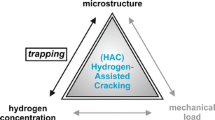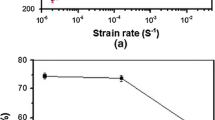Abstract
Hydrogen trapping behavior has been investigated by means of thermal desorption spectroscopy (TDS) for a high strength steel after it was tempered at the temperatures of 430 °C, 500 °C and 520 °C, respectively. The loss of ductility was characterized by slow strain rate test (SSRT) and microscopic observation. It shows that with hydrogen charging the fracture feature transfers from ductile to brittle, resulting in the loss of ductility. Undeformed microstructure immediately beneath the fracture surface in charged specimen corresponds to badly ductility compared to the obviously streamline plastic deformation in uncharged specimen. The activation energies for the peaks present in the TDS analysis are calculated for all tested steel and the activation energies for all temperature peaks are similar, corresponding to the similar types of hydrogen traps.
Similar content being viewed by others
References
MATSUYAMA S. Delayed fracture of high strength steels [J]. Journal of the Iron and Steel Institute of Japan, 1994, 80(9): 679–684.
YAN Chun-yan, LIU Cui-ying, ZHANG Gen-yuan. Simulation of hydrogen diffusion in welded joint of X80 pipeline steel [J]. Journal of Central South University, 2014, 21(12): 4432–4437.
WANG Mao-qiu, DONG Han, HUI WEI-Jun, CHEN Si-lian, WENG Yu-qing. Effect of heat treatment on delayed fracture resistance of high strength steel 30CrMnSi2NiNb [J]. Journal of Iron and Steel Research, International, 2003, 10(1): 44–48.
MARCHETTI L, HERMS E, LAGHOUTARIS P, CHENE J. Hydrogen embrittlement susceptibility of tempered 9%Cr-1%Mo steel [J]. International Journal of Hydrogen Energy, 2011, 36(24): 15880–15887.
LI Yang, ZHANG Yong-jian, HUI Wei-jun, WANG Mao-qiu, DONG Han. Hydrogen induced delayed fracture behavior of high strength steel 42CrMoVNb [J]. Journal of Iron and Steel Research, 2011, 23(12): 35–39. (in Chinese)
WANG Si-zhen, CHENG Xiao-ying, FENG Pei-gong. Effect of tempering temperature on hydrogen diffusion behaviors in mooring chain steel of level R5 [J]. Heat Treatment of Metals, 2013, 38(9): 10–15. (in Chinese)
TARTAGLIA J M, LAZZARI K A, HUI G P, HAYRYNEN K L. A comparison of mechanical properties and hydrogen embrittlement resistance of austempered vs quenched and tempered 4340 steel [J]. Metallurgical and Materials Transactions A, 2008, 39(3): 559–576.
ELIAZ N, SHACHAR A, TAL B, ELIEZER D. Characteristics of hydrogen embrittlement, stress corrosion cracking and tempered martensite embrittlement in high strength steels [J]. Engineering Failure Analysis, 2002, 9(2): 167–184.
AKIYAMA E, LI Song-jie, SHINOHARA T, ZHANG Zuo-gui, TSUZAKI K. Hydrogen entry into Fe and high strength steels under simulated atmospheric corrosion [J]. Electrochimica Acta, 2011, 56(4): 1799–1805.
CHOO W Y, LEE J Y. Thermal analysis of trapped hydrogen in pure iron [J]. Metallurgical Transactions A, 1982, 13(1): 135–140.
SALEMI A, ABDOLLAH Z A. The effect of tempering temperature on the mechanical properties and fracture morphology of a NiCrMoV steel [J]. Materials Characterization, 2008, 59(4): 484–487.
ORIANI RA. The diffusion and trapping of hydrogen in steel [J]. Acta Metallurgica, 1970, 18(1): 147–157.
AYAS C, DESHPANDE V S, FLECK N A. A fracture criterion for the notch strength of high strength steels in the presence of hydrogen [J]. Journal of the Mechanics and Physics of Solids, 2014, 63: 80–93.
SOFRONIS P, MCMEEKING RM. Numerical analysis of hydrogen transport near a blunting crack tip [J]. Journal of the Mechanics and Physics of Solid, 1989, 37(3): 317–350.
NOVAK P, YUAN R, SOMERDAY B, SOFRONIS P, RITCHIE R. A statistical, physical-based, micro-mechanical model of hydrogen-induced intergranular fracture in steel [J]. Journal of the Mechanics and Physics of Solid, 2010, 58(2): 206–226.
CAMEEIRO FILHO C J, MANSUR M B, MODENESI P J, GONZALEZ B M. The effect of hydrogen release at room temperature on the ductility of steel wire rods for pre-stressed concrete [J]. Materials Science and Engineering A, 2010, 527(18): 4947–4952.
FERRIN P, KANDOI S, NILEKAR A U. Hydrogen adsorption, absorption and diffusion on and in transition metal surfaces: A DFT study [J]. Surface Science, 2012, 606(7/8): 679–689.
KISSINGER H E. Reaction kinetics in different thermal analysis [J]. Analytical Chemistry, 1982, 29: 135–140.
GU J L, CHANG K D, FANG H S, BAI B Z. Delayed fracture properties of 1500 MPa bainite/martensite dual-phase high strength steel and its hydrogen traps [J]. ISIJ International, 2002, 42(12): 1560–1564.
PRESSOUYRE G M. A classification of hydrogen traps in steel [J]. Metallurgical and Materials Transactions A, 1979, 10(10): 1571–1573.
ESCOBAR D P, VERBEKEN K, DUPREZ L. Evaluation of hydrogen trapping in high strength steels by thermal desorption spectroscopy [J]. Materials Science and Engineering A, 2012, 551: 50–58.
LI Song-jie, ZHANG Zuo-gui, AKIYAMA E, TSUZAKI K, Zhang B. Evaluation of susceptibility of high strength steels to delayed fracture by using cyclic corrosion test and slow strain rate test [J]. Corrosion Science, 2010, 52(5): 1660–1667.
ASM. Materials Handbook, Metals Handbook [M]. 9th Ed., Materials Park, OH: ASM International, 1987: 330.
LIU Yan, WANG Mao-qiu, LIU Guo-quan. Effect of hydrogen on ductility of high strength 3Ni-Cr-Mo-V steels [J]. Materials Science and Engineering A, 2014, 594: 40–47.
Author information
Authors and Affiliations
Corresponding author
Additional information
Foundation item: Project(TZ-J110302) supported by Luoyang Sunrui Special Equipment Co., Ltd., China
Rights and permissions
About this article
Cite this article
Sun, Yw., Chen, Jz. & Liu, J. Hydrogen trapping in high strength 0Cr16Ni5Mo martensitic stainless steel. J. Cent. South Univ. 22, 4128–4136 (2015). https://doi.org/10.1007/s11771-015-2959-y
Received:
Accepted:
Published:
Issue Date:
DOI: https://doi.org/10.1007/s11771-015-2959-y




